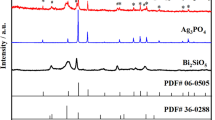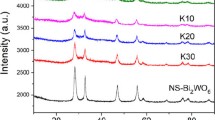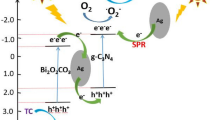Abstract
Novel visible-light-driven Ag/AgCl/Bi2Zr2O7 plasmonic photocatalysts were successfully synthesized through a two-step process. Bi2Zr2O7 nanosheets were firstly prepared via a precipitation-calcination method, and Ag/AgCl nanoparticles were deposited on the surface of Bi2Zr2O7 nanosheets by an ultrasonic-assisted precipitation-photoreduction technique. The composition, phase structures, morphologies and optical properties of the Ag/AgCl/Bi2Zr2O7 catalysts were characterized by scanning electron microscopy (SEM), transmission electron microscopy (TEM), X-ray diffraction (XRD), UV–vis diffuse reflectance spectroscopy (DRS) and X-ray photoelectron spectroscopy (XPS). The results showed that the Ag ions were finally formed on the surface of AgCl by in situ photoreaction. The visible-light photocatalytic activity of the as-prepared samples was investigated by the degradation of methyl orange aqueous solution. Compared to Bi2Zr2O7, the Ag/AgCl/Bi2Zr2O7 photocatalysts showed superior photocatalytic activities, which sould be attributed to the high specific surface area of the catalysts, the surface plasmon resonance effects of Ag and the formation of a heterostructure between Ag, AgCl and Bi2Zr2O7. It would provide a promising candidate material for environment remediation.
Similar content being viewed by others
Explore related subjects
Discover the latest articles, news and stories from top researchers in related subjects.Avoid common mistakes on your manuscript.
1 Introduction
Nowadays, the treatment of nonbiodegradable contamination in the wastewater is very difficult. Recently, semiconductor photocatalysis has been recognized as a green technique, which can degrade organic contaminants effectively by using solar energy [1, 2]. Semicondutor photocatalyst is the determining factor, and many kinds of effective photocatalysts have been developed. Among them, titanium dioxide (TiO2) is the most widely used semiconductor, due to the low cost, nontoxicity, and high chemical stability [3, 4]. However, TiO2 was greatly limited on account of its relatively wide band gap (~3.2 eV), which can only utilize the ~5% of the solar light. Therefore, the visible-light-driven photocatalysts have been developed to enhance the energy efficiency of solar light [5].
Recently, a family of bismuth-containing semiconductors, such as Bi2WO6 [6], Bi2O2CO3 [7], has attracted a great deal of attention because of their photoresponse in the visible light region. As an Bi(III)-based semiconductor, Bi2Zr2O7 is one of newly developed photocatalysts [8, 9]. Unfortunately, the photocatalytic efficiency of pure Bi2Zr2O7 is unsatisfactory owning to the poor quantum yield, due to rapid electron–hole recombination and potentially poor surface chemistry. To enhance the photocatalytic activity of Bi2Zr2O7, the design and construction of the new composites is one of the most effective ways, because composite photocatalysts can reduce the electron–hole recombination rate [10, 11]. Lately, coupling semicondutor with Ag/AgCl composites attracts considerable attention [12, 13]. Ag NPs with the surface plasmon resonance (SPR) effect can enhance the visible light efficiency and the highly deposited AgCl nanoparticles can promote the charge separation of as-prepared composites [14, 15]. For instance, Yin et al. reported that Ag/AgCl/TiO2 hollow sphere exhibited outstanding photocatalytic activity for the degradation of Rhodamine B [16]. Xu et al. prepared core–shell magnetic Ag/AgCl@Fe2O3 photocatalysts via a two-step method, which exhibited excellent properties in eliminating the colorless pollutant bisphenol A and microbial contamination [17]. Therefore, it would be a better method for enhancing the photocatalytic performance of Bi2Zr2O7 by modification with the plasmonic Ag/AgCl nanoparticles.
In the present work, Ag/AgCl decorated Bi2Zr2O7 photocatalyst, designed as Ag/AgCl/ Bi2Zr2O7, was successfully fabricated. Bi2Zr2O7 nanosheets were synthesized via a precipitation-calcination method, and Ag/AgCl nanoparticles were deposited on the surface of Bi2Zr2O7 nanosheets via a precipitation-photoreduction reaction. The obtained samples were investigated by means of SEM, TEM, XRD, DRS, XPS. The photocatalytic activities of the Bi2Zr2O7and Ag/AgCl/Bi2Zr2O7 were evaluated by the photocatalytic decolorization of methyl orange (MO) aqueous solution under visible-light irradiation. Compared with the pure Bi2Zr2O7 photocatalyst, the prepared Ag/AgCl/Bi2Zr2O7 composites showed much higher photoactivity. Furthermore, the degradation mechanism of MO over the Ag/AgCl/Bi2Zr2O7 composites is discussed through a systematic investigation and analysis.
2 Experimental
2.1 Preparation of Bi2Zr2O7 sample
Bi2Zr2O7 nanosheets were synthesized by a precipitation-photoreduction reaction: Bi(NO3)3·5H2O (0.01 mol) was firstly dissolved in HNO3 solution (2 mol/L, 30 mL) under continuously magnetic stirring, followed by the addition of 0.01 mol glucose to form a homogeneous solution (A) Secondly, Zr(NO3)4·5H2O (0.01 mol) was dissolved in H2O (30 mL) under continuously magnetic stirring, followed by the addition of 0.01 mol glucose to form a homogeneous solution (B) After that, solution A was added drop-wisely into solution B. Then, the pH of the mixture suspension was adjusted to 8 by NaOH solution (1 mol/L) and then obtained the white precipitate. After about 1 h aging, the precipitate was filtrated through a filter paper and washed with deionized water for 5 times, and then grinded with urea (2.40 g) in mortar to form the intimate mixture. Afterwards the intimate mixture was dried under vacuum at 80 °C for overnight and submitted to a further calcination at 600 °C for 4 h in a muffle furnace. After it cool, the calcinate was washed by water and alcohol to remove the impurity, and then dried at 80 °C in air for overnight. The product obtained was denoted Bi2Zr2O7.
2.2 Preparation of Ag/AgCl/Bi2Zr2O7 sample
Ag/AgCl NPs were deposited onto the Bi2Zr2O7 samples via a precipitation-photoreduction method. Typically, the synthesized Bi2Zr2O7 samples (1.00 g) were dispersed in 50 mL deionized water and sonicated for 10 min. Then 3 mL of 0.1 mol/L AgNO3 solution was added into the Bi2Zr2O7suspension and sonicated for another 10 min. After stirring magnetically for 20 min, 6 mL of 0.1 mol/L HCl aqueous solution was added, sonicated for 10 min and stirred magnetically for 20 min. Subsequently, the resulting suspension was irradiated by a 300 W Xe lamp for 30 min to reduce partial Ag+ ions in the AgCl particles to Ag0 species by photochemical decomposition of AgCl. The whole reaction process was kept at room temperature. Finally, Ag/AgCl/Bi2Zr2O7 samples were collected, washed for several times until the pH of the suspension was about 7, filtrated and dried at 80 °C for several hours.
2.3 Characterization of catalysts
X-ray powder diffraction (XRD) pattern of samples were recorded on a powder X-ray diffractometer (D/max-2200/PC, Rigaku Corporation, Japan) with Cu Ka radiation, operating at 40 kV and 30 mA, where λ= 0.15418 nm for the Cu Kα line. XPS experiments were carried out on a RBD upgraded PHI-5000C ESCA system (Perkin Elmer, USA), the shift of the binding energy due to relative surface charging was corrected using the C 1 s level at 284.6 eV as an internal standard. The structure and morphology of the coatings were investigated by the field emission scanning electron microscopy (FESEM, FEI SIRION 200, FEI, USA) and the transmission electron microscopy (TEM, JEM-100CX, JEOL, Japan). UV–Vis diffuse reflectance spectra (DRS) of the samples were recorded on a UV–Vis spectrophotometer (TU-1901) with an integrating sphere attachment. The analyzed range was 200–800 nm, and BaSO4 was used as a reflectance standard.
2.4 Photocatalytic degradation of MO
The photocatalytic activity of the catalysts was evaluated by degradation of methyl orange (MO) under visible light irradiation. A 300 W Xe lamp was used as the light source of a homemade photoreactor, surrounded with a water circulation facility at the outer wall through a quartz jacket. The 420 nm cut off filter was used to get the visible light source. In each experiment, 0.05 g of the as-prepared photocatalyst was added into 50 mL of MO solution (10 mg/L). Before irradiation, the suspensions were placed in dark and stirred for 30 min to achieve adsorption equilibrium. Subsequently, MO solution was sampled at every interval and the residual MO concentration was monitored at 464 nm using a UV–vis spectrophotometer (UNICO 7200).
3 Results and discussion
3.1 Phase structure
The crystal structures of Bi2Zr2O7 and Ag/AgCl/Bi2Zr2O7 samples were characterized by XRD analysis (Fig. 1). The diffraction peaks of Bi2Zr2O7 perfectly match the reported results [8]. Comparing with the pure Bi2Zr2O7, Ag/AgCl/Bi2Zr2O7 showed some new diffraction peaks, which are indexed to the cubic phase of AgCl (JCPDS No. 31-1238) and the cubic phase of Ag (JCPDS No. 04-0783). The diffraction peaks at 2θ = 27.52°, 32.12°, 45.89°, 54.71° and 57.16°, marked with “*”, were attributed to (111), (200), (220), (311) and (222) planes of AgCl, respectively [18]. Moreover, the peak at 38.44°, marked with “#”, was indexed to (111) plane of metallic Ag. Meanwhile, no appreciable changes in the diffraction peaks of Bi2Zr2O7 in Ag/AgCl/Bi2Zr2O7 were detected, which implies that Ag/AgCl nanoparticles should only be deposited on the surface of Bi2Zr2O7 instead of getting into the crystal lattice [14, 19]. In addition, the crystallite diameter (Dc) of AgCl nanoparticles can be calculated to be 5 nm according to Scherrer’s equation, D c =Kλ/(βcosθ), where λ is the X-ray wavelength, β is the FWHM of the diffraction line, θ is the diffraction angle, and K is a constant, which has been assumed to be 0.9 [20, 21].
3.2 Morphological structure
The morphology and microstructure of Ag/AgCl/Bi2Zr2O7 were examined by SEM, as presented in Fig. 2. In the low magnification SEM image (Fig. 2a), all of the sheet-shape objects were Bi2Zr2O7 nanosheets. Observed from the high magnification SEM image (Fig. 2b), many Ag/AgCl nanoparticles were assembled on the surface of the Bi2Zr2O7 nonosheets with the thickness of about 10–20 nm. TEM was used to further investigate the phase structure of the Ag/AgCl/Bi2Zr2O7 composites. As shown in Fig. 3a, the Bi2Zr2O7 nanosheets are very thin and are nearly transparent under electron beam. Furthermore, a large number of uniform Ag@AgCl nanoparticles with a diameter around 10 nm are distinctly observed on the surface of the Bi2Zr2O7 nanosheets, which was in accordance with the SEM results. From the HRTEM image of the edge section of Ag/AgCl/Bi2Zr2O7 (Fig. 3b), the junction region between Bi2Zr2O7, AgCl and Ag metal can be observed clearly, which further confirms the formation of nanojunctions between Ag/AgCl and Bi2Zr2O7. The observed lattice fringes of 0.235, 0.277 and 0.326 nm were consistent with the (100) plane of metallic Ag, (200) plane of AgCl and (222) plane of Bi2Zr2O7, respectively.
3.3 Opitical absorption properties
Light absorption properties of Bi2Zr2O7 and Ag/AgCl/Bi2Zr2O7 composites were studied by the UV–vis diffuse reflectance spectroscopy, as shown in Fig. 4. Bi2Zr2O7 sample shows absorption in the visible light region. In contrast to Bi2Zr2O7, the absorption intensity of Ag/AgCl/Bi2Zr2O7 composites was stronger and the photoabsorption region was expanded. AgCl almost had no effect on the light absorption property because of the big band gap [22, 23]. Therefore, this result is mainly to the contribution of Ag nanocrystals due to its strong surface plasmon absorption. Remarkable absorption enhancement in the visible light region is good for enhancing the photocatalytic performance of Ag/AgCl/ Bi2Zr2O7 composite.
3.4 Surface chemical states
XPS surface measurement was performed to investigate the surface chemical composition and chemical states of Ag/AgCl/Bi2Zr2O7 sample. The spectrum of Bi 4 f consists of two peaks at around 158.0 and 163.4 eV (Fig. 5a), which are assigned to Bi 4f7/2 and Bi 4f5/2, respectively [24]. From Zr 3d spectra in Fig. 5b, two distinct peaks at 181.0 and 183.4 eV are assigned to Zr 3d5/2 and Zr 3d3/2, respectively [25]. Observed from Fig. 5c, the spectrum of Ag 3d consists of two main peaks at about 367.0 and 373.1 eV, which are assigned to Ag 3d5/2 and Ag 3d3/2, respectively. The Ag 3d5/2 peak can be further divided into two different peaks at 366.9 and 368.3 eV. Similarly, the Ag 3d3/2 peak can be divided into two different peaks at 373.0 and 374.2 eV. The peaks at 366.9 and 373.0 eV should be attributed to the peaks of Ag 3d5/2 and Ag 3d3/2 of Ag+ in AgCl, whereas the peaks at 368.3 and 374.2 eV could be ascribed to the peaks of Ag 3d5/2 and Ag 3d3/2 of metallic Ag0 respectively [26]. These results confirmed the existence of metallic Ag in the Ag/AgCl/Bi2Zr2O7 composite, which are consistent with the XRD analysis. In Fig. 5d, two peaks at 197.1 and 198.9 eV are ascribed to the binding energies of Cl 2p3/2 and Cl 2p1/2, respectively [27].
3.5 Photocatalytic activity
The photocatalytic activity of Bi2Zr2O7 and Ag/AgCl/Bi2Zr2O7 samples was assessed by decomposing MO under visible light irradiation. Observed from Fig. 6a, the blank test confirmed that the photoinduced self-sensitized photolysis of MO can be negligible in the absence of photocatalyst. Figure 6b showed that the pure Bi2Zr2O7 only slightly degraded the MO under visible light irradiation, and the degradation efficiency of MO solution is less than 15% after 60 min. Whereas, the Ag/AgCl/Bi2Zr2O7 photocatalysts exhibited outstanding photocatalytic activity under identical experimental conditions. MO was nearly quantitatively decomposed within 40 min. The outstanding photocatalytic performance of Ag/AgCl/Bi2Zr2O7 should be attributed to the following several respects. Firstly, the nanosheet structure of Bi2Zr2O7 and the crystal size of Ag/AgCl (around 10 nm) can endow the Ag/AgCl/Bi2Zr2O7 photocatalyst with high specific surface area, which would offer more active sites and enable fast surface photocatalytic reactions and quick mass transfer of active species [28, 29], leading to good photocatalytic activity. Secondly, the metallic Ag nanoparticles can effectively enhance utilization efficiency of solar energy due to the surface plasmon resonance effect, leading to an increase in the generation of photo-induced charge carriers [30]. Thirdly, the interaction between Ag/AgCl and Bi2Zr2O7 can speed up the separation of electrons and holes, and it may be beneficial to improve the photocatalytic ability [12, 31]. The result showed that the Ag/AgCl/Bi2Zr2O7 composites were excellent visible-light-induced photocatalysts in catalyzing degradation of organics.
4 Conclusions
In summary, novel Ag/AgCl/Bi2Zr2O7 composites were prepared via a facile multistep route, in which a precipitation-calcination method was employed to synthesize Bi2Zr2O7 nanosheets, and an ultrasonic-assisted precipitation-photoreduction technique was used to deposite Ag/AgCl nanoparticles on the surface of Bi2Zr2O7 photocatalysts. The results observed from SEM and TEM showed that a large number of Ag/AgCl nanoparticles with a diameter around 10 nm were assembled on the surface of the Bi2Zr2O7 nonosheets with the thickness of about 10–20 nm. XRD and XPS confirmed the existence of metallic Ag in the as-prepared composites by reducing part of Ag+ in AgCl. The UV–vis DRS displayed that the Ag/AgCl/Bi2Zr2O7 composites possess absorption enhancement in the visible light region ascompared to Bi2Zr2O7 nonosheets, which can be attributed to the surface plasmon resonance of Ag NPs. The photocatalytic experiment results revealed that the Ag/AgCl/Bi2Zr2O7 composites show outstanding visible light photocatalytic activities for degradations of MO aqueous solution, which can be ascribed to the high specific surface area of the catalysts, the excellent photo-response of Ag NPs in the visible light region and the formation of a heterostructure between Ag, AgCl and Bi2Zr2O7. The present work suggests that the Ag/AgCl/Bi2Zr2O7 composites can be regarded as a promising photocatalyst for degrading environmental pollutants.
References
W. Dong, Y. Sun, W. Hua, Y. Yao, G. Zhuang, X. Lv, Q. Ma, D. Zhao, Adv. Funct. Mater. 26, 964 (2016)
M. Vosoughifar, J. Mater. Sci-Mater. El. 27, 10449 (2016)
Y. Ide, N. Inami, H. Hattori, K. Saito, M. Sohmiya, N. Tsunoji, K. Komaguchi, T. Sano, Y. Bando, D. Golberg, Y. Sugahara, Angew. Chem. Int. Edit. 55, 3600 (2016)
M. Thamima, S. Karuppuchamy, J. Mater. Sci-Mater. El. 27,458 (2016)
S.M. Hosseinpour-Mashkani, M. Maddahfar, A. Sobhani-Nasab, J. Electron. Mater. 45, 3612 (2016).
G. Zhu, Q.F. Zhao, X.L. Li, H.Y. Wang, L. Zhang, J. Mater. Sci-Mater El. 27, 8288 (2016)
M.C. Long, P.D. Hu, H.D. Wu, J. Cai, B.H. Tan, B.X. Zhou, Appl. Catal. B-Environ. 184, 20 (2016)
D. Wu, T. He, J. Xia, Y. Tan, Mater. Lett. 156, 195 (2015)
V.M. Sharma, D. Saha, G. Madras, T.N.G. Row, Rsc Adv. 3, 18938 (2013)
K.M. Butt, M.A. Farrukh, I. Muneer, J. Mater. Sci-Mater El. 27, 8493 (2016)
M. Ebadi, Z. Zarghami, M. Aliabadi, J. Mater. Sci-Mater. El. 27, 1622 (2016)
A.R. Upreti, Y. Li, N. Khadgi, S. Naraginti, C. Zhang, Rsc Adv. 6, 32761 (2016)
T. Zhou, Y.G. Xu, H. Xu, H.F. Wang, Z.L. Da, S.Q. Huang, H.Y. Ji, H.M. Li, Ceram. Int. 40, 9296 (2014)
D.B. Xu, W.D. Shi, C.J. Song, M. Chen, S.B. Yang, W.Q. Fan, B.Y. Chen, Appl. Catal. B-Environ. 19, 1228 (2016)
J. Zhang, C. Niu, J. Ke, L. Zhou, G. Zeng, Catal. Commun 59, 30 (2015)
H. Yin, X. Wang, L. Wang, Q. Nie, Y. Zhang, Q. Yuan, W. Wu, J. Alloys Compd. 657, 44 (2016)
Y.G. Xu, S.Q. Huang, M. Xie, Y.P. Li, L.Q. Jing, H. Xu, Q. Zhang, H.M. Li, New J. Chem. 40, 3413 (2016)
T.B. Devi, S. Begum, M. Ahmaruzzaman, J. Photoch.Photobio.B 160, 260 (2016)
X. Xiao, W.D. Zhang, J.Y. Yu, Y.J. Sun, Y.X. Zhang, F. Dong, Catal. Sci. Technol. 6, 5003 (2016)
A. Sobhani-Nasab, M. Maddahfar, S.M. Hosseinpour-Mashkani, J. Mol. Liq. 216, 1 (2016).
S.M. Hosseinpour-Mashkani, A. Sobhani-Nasab, M. Mehrzad, J. Mater. Sci-Mater El. 27, 5758 (2016).
C. An, S. Peng, Y. Sun, Adv. Mater. 22, 2570 (2010)
J. Jiang, L.Z. Zhang, Chem-Eur.J. 17, 3710 (2011)
H.Y. Jiang, H.X. Dai, J.G. Deng, Y.X. Liu, L. Zhang, K.M. Ji, Solid State Sci. 17, 21 (2013)
Y. Zhao, Y. Zhang, J. Li, X. Du, Mater. Lett. 130, 139 (2014)
X. Li, S. Fang, L. Ge, C. Han, P. Qiu, W. Liu, Appl. Catal. B-Environ. 176, 62 (2015)
H. Li, Y. Sun, B. Cai, S. Gan, D. Han, L. Niu, T. Wu, Appl. Catal. B-Environ. 170, 206 (2015)
K. Wang, C. Shao, X. Li, X. Zhang, N. Lu, F. Miao, Y. Liu, Catal. Commun. 67, 6 (2015)
Z. Zhu, H. Tian, M. Zhang, B. Liang, W. Li, Ceram. Int. 42, 14743 (2016)
S.M. Harshulkhan, K. Janaki, G. Velraj, R.S. Ganapthy, M. Nagarajan, J. Mater. Sci-Mater El. 27, 4744 (2016)
T.J. Yao, L. Shi, H. Wang, F.X. Wang, J. Wu, X. Zhang, J.M. Sun, T.Y. Cui, Chem-Asian J. 11, 141 (2016)
Acknowledgements
This project was funded by the Natural Science Foundation of China (51408204) and Hubei University for Nationalities (MY2013T005).
Author information
Authors and Affiliations
Corresponding author
Rights and permissions
About this article
Cite this article
He, T., Wu, D. Synthesis and characterization of Ag/AgCl/Bi2Zr2O7 photocatalyst with enhanced visible-light-driven photocatalytic performance. J Mater Sci: Mater Electron 28, 7320–7325 (2017). https://doi.org/10.1007/s10854-017-6418-4
Received:
Accepted:
Published:
Issue Date:
DOI: https://doi.org/10.1007/s10854-017-6418-4










